INTRODUCTION
Historically, in the protected areas of Colombia’s National Natural Parks System (NNPS) linked to the Caribbean Territory Directorate (CADT), there has been constant utilization of fishery resources by the local communities, causing heavy pressure on the utilized species (Manjarrés, 2007; Martínez-Viloria, 2014). As part of the monitoring of the fishing activity carried out by CADT in five protected areas with marine-coastal jurisdiction, about 1600 fishermen were identified, on which about 4700 people depend economically (Martínez-Viloria et al., 2014). Likewise, it has been documented that many species exploited by fishing are under heavy pressure, which could contribute negatively to their population status (López, 2009; Guzmán, 2010; Jaimes, 2011; Martínez-Viloria et al., 2011).
The lane snapper (Lutjanus synagris) is among the most exploited species in the protected areas of Corales del Rosario y de San Bernardo National Natural Park (CRSBNNP), Tayrona National Natural Park (TNNP), and Salamanca Island Park Way (SIPW) (López, 2009; Guzmán, 2010; Pardo, 2011; Martínez-Viloria et al., 2011; Martínez-Viloria, 2014). Lutjanus synagris is a demersal, generalist carnivorous, and opportunist species, distributed from North Carolina (USA) to southeastern Brazil (Allen, 1985; Cervigón et al.,1992; Doncel and Páramo, 2010), including the Greater Caribbean. Its growing demand and commercial value have turned it into an important source of income for regional fisheries of countries such as Bermuda, Cuba, Puerto Rico, Venezuela, and Colombia (Luckhurst et al., 2000; Gómez et al., 2001; Claro and Lindeman, 2008; Amorim et al., 2018). Some biological-fishing aspects indicate that L. synagris can be considered to be a species vulnerable to overexploitation in Colombia due to (i) the species’ biological characteristics. such as rapid growth during the first year of life and growth deceleration in the third and fourth years, reaching sexual maturity at its first year, and seasons of reproductive aggregation (Coleman et al., 2000; Luckhurst et al., 2000; Claro and Lindeman, 2008); (ii) the evident fishing pressure by the artisanal and semi-industrial fleet (Mejía and Acero, 2002; Manjarrés, 2004; Barreto and Borda, 2009; De La Hoz et al, 2013, 2017; Altamar et al., 2020); (iii) the fishing effort increase in the Caribbean region due to the artisanal fleet’s technical and technological innovations (Manjarrés, 2004); (iv) the historic decrease in catches both by the artisanal fleet (Correa and Manjarrés, 2004) and the industrial trawl fleet (Viaña et al., 2004); (v) the deterioration of their recruitment, development, and residence habitats such as coral reefs, lagoons and marshes (Mejía and Acero, 2002); and (vi) the decrease in maturity age in places with higher fishing effort (Arteaga et al., 2004).
On the other hand, the presence of the lane snapper in protected areas is related to the disposition of strategic habitats where this species spends part of the time during its natural cycle performing predator functions, which contribute to the reefs’ organic enrichment (Claro and Lindeman, 2008). Therefore, utilization must not include catching specimens under the sexual maturity length (Lmat), nor affect the mega-spawners’ cohort, because the latter ensures genetic vigor and larger offspring to ensure the survival of populations (Longhurst, 2002; Hsieh et al., 2006).
In this context, and considering the permanent pressure exerted by artisanal fishing on L. synagris with different fishing gears and methods used in the Colombian Caribbean, the purpose of this research was to evaluate the condition of the lane snapper based on limited data of length from landings of catches in the protected areas CRSBNNP, TNNP, and SIPW. This paper contributes to measuring the effect of fishery on L. synagris in each protected area and provide decision-making recommendations for designing and implementing management strategies that contribute to fishery ordering in the Colombian Caribbean, for protected areas to become strategic sites providing favorable conditions for fish species to endure and be used indefinitely (Roberts et al., 2001; Di Lorenzo et al., 2016).
STUDY AREA
This research was conducted in the protected areas of Corales del Rosario y de San Bernardo National Natural Park (CRSBNNP), Tayrona National Natural Park (TNNP), and Salamanca Island Park Way (SIPW) (Figure 1). TNNP is located to the northeast of Santa Marta, in the department of Magdalena (11° 16’ 20” N, 74° 12’ 56” W to 11° 21’ 33” N, 73° 53’ 11” W) (PNNC, 2006). It has 15,000 ha, 3,000 of which in the marine area. More than 200 fishermen in this area reported using different fishing gears and/or methods (Martínez-Viloria, 2009; Martínez-Viloria et al., 2014)). The conflict of use for fishing has been historical, and the Colombian Constitutional Court’s Sentence T-606 of 2015 orders no fishing in the protected areas, unless it is for subsistence purposes.
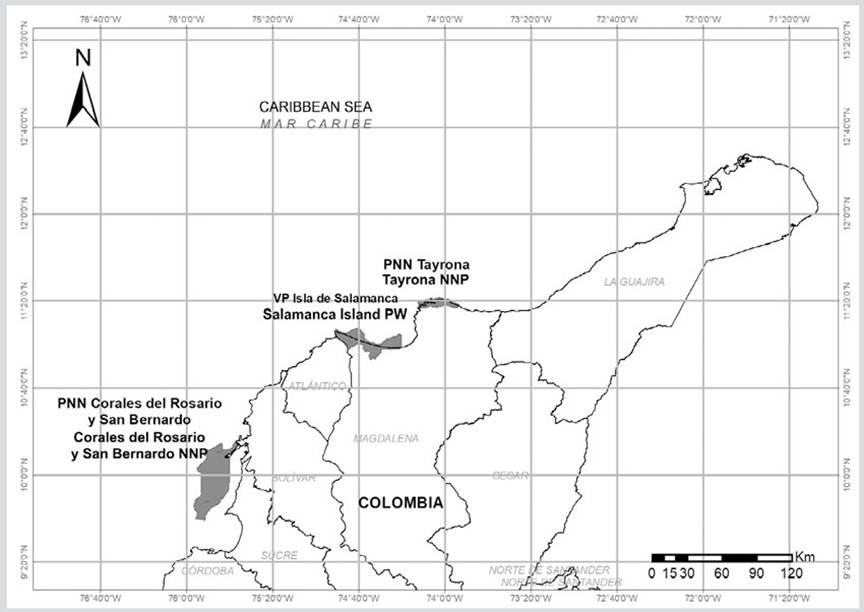
Figure 1 Location of the Caribbean Territorial Directorate’s protected areas: Tayrona National Natural Park (TNNP), Salamanca Island Park Way (SIPW), and National Natural Park Corales del Rosario y de San Bernardo (CRSBNNP).
The CRSB NNP is located 45 km southwest of Cartagena, and 30 km northwest of Tolú, between the departments of Bolívar and Sucre, within the jurisdiction of the Tourist and Cultural District of Cartagena de Indias (10º 15’ to 9º 35’ N, and 75º 47’ to 75º 50’ W) (PNNC, 2020). In total, 120,000 ha belong to this protected area, 118,800 ha of which (99 %) are marine. In this protected area, more than 600 fishermen make use of the resources through fishing (Martínez-Viloria et al., 2011).
The SIPW is located in the coastal sector of the department of Magdalena, in the jurisdiction of the Pueblo Viejo and Sitio Nuevo municipalities (11° 7’ 19” to 10° 53’ 07” N, and 74° 20’ 34” to 74° 51’ 00” O) (PNNC, 2017). It has 56,200 ha, 28,200 of which are in marine areas. It has been identified that more than 350 fishermen carry out fishing activities within it (Martínez-Viloria, 2009, 2014), using fishing gears such as trawl nets (Cochrane, 2005).
MATERIALS AND METHODS
Description of fishing gears and/or methods
Handline. It is a fishing gear used to catch demersal species in the Colombian Caribbean with different operating forms or methods (subject to vessel movement), among which are i) fixed or anchored boats, and ii) drifting boats (with the motor in minimum motion to test the area and the bottom for the best catch) (Aunap-Unimagdalena, 2014). The handline is the most used gear in protected areas (34 %; Martínez-Viloria et al., 2014). It consists of a monofilament-type nylon cord with strength from 3 to 120 kgf equipped with one to six hooks per line, mostly “J”-type, between numbers J6 and J12. In general, nylon of 35 to 120 kgf is used in the TNNP as primary line with a length between 90 to 200 m, and J-type hooks numbers 7, 9, and 10. In the CRSBNNP, there are similar characteristics to those in the TNNP, in addition to the use of numbers C5 and C6 circular or curved type hooks.
Fixed gillnet. They represent 23 % of the gears used in the protected areas (Martínez-Viloria et al., 2014), and consist of one or several mostly monofilament meshes. Those used in the TNNP have lengths up to 225 m, 17 m maximum height, and mesh sizes between 8.89 and 11.43 cm (3.5 and 4.5”). In the CRSBNNP, mesh sizes are between 5.08 and 8.89 cm (2.0 and 3.5”). In the SIPW, they are between 5.08 and 7.62 cm (2.0 and 3.0”).
Diving. This extracting method is practiced in the TNNP and the CRSBNNP. It is usually practiced at depths between 3 and 20 m, with spears to catch fish, or without spears to catch snails (Eustrombus gigas, Melongena melongena, Cittarium pica), lobsters (Panulirus argus), and octopi (Octopus spp.); it is also done with sticks, hooks, and snares to catch lobsters and octopi.
Longlining. It consists of a mono- or multifilament nylon primary cord or horizontal mainline of 60 to 120 kgf in the TNNP, and 20 to 60 kgf in the SIPW, to which secondary lines (leaders) are attached at regular distances (~1.2 m in the SIPW and ~3.6 m in the TNNP), with J-type hooks at the ends between numbers 9, 10, and 12 in the SIPW and 7, 8, and 10 in the TNNP. They are mostly used in the SIPW down to 20 m deep, and down to 200 m deep in the TNNP, with 100 to 300 hooks for fishing demersal fish.
Data collection and analysis of information
The landed fish total length (cm) was recorded on a monthly basis between 2006 and 2012, measured with a 0.1 cm precision ichthyometer, and grouped into 0.5 cm class marks in the CRSBNNP and SIPW and between 2006 to 2010 in the TNNP. These records of L. synagris were stratified by protected area, by fishing gear and/or method, and by year, making in every area a sampling effort greater than 30 % of the Active Fishing Economic Units. This was done following the methodology described in the Fishing Information System of Invemar-Sipein Ver. 3.0 (Narváez et al., 2005).
Biological reference points
The analysis of data was based on the following biological reference points (BRP): i) sexual maturity length, corresponding to the length at which 50 % of the fish in a given population become sexually mature for the first time (Lmat; Froese and Binohlan, 2000; Cope and Punt, 2009; Fontoura et al., 2009); ii) optimal catch length, which is the length at which an unfished cohort reaches its maximum growth and biomass rate (Lopt; Froese et al., 2008); and the length of mega-spawners (Lmega), which represents the caught specimens above 10 % of Lopt (Froese, 2004); 0.25 of the spawning biomass-SB (Cope and Punt, 2009) was also used as a limit reference point.
This research considered that, in each protected area, there is a genetically differentiated population of L. synagris (Fst > 0.061, p < 0.05; Narváez et al., 2015). Therefore, independent values of Lmat were assumed, as obtained from previous research conducted in each protected area and for combined sexes (PNNT = 33.08 cm, Arteaga et al., 2004; VIPIS = 30.6 cm, Pardo, 2011; PNNCRSB = 24.6 cm, Jaimes, 2011). Lopt and Lmega values were calculated in this study following the methods of Froese and Binohlan (2000) and Froese et al. (2008).
where Lopt is the optimal catch length, and Lmat is the sexual maturity length.
Indicators based on L. synagris catch lengths
To evaluate the status of the lane snapper populations, the following indicators suggested by Cope and Punt (2009) were used: i) P mat , is the proportion of individuals of L. synagris caught above Lmat; ii) P opt , is the proportion determined from caught specimens between 0.9 and 1.1 of Lopt; iii) P mega , is the proportion of specimens caught above Lmega; iv) P obj , is the sum of the length proportions.
To determine the impact trends of fishing activity on L. synagris in each protected area, a regression analysis was carried out with the proportion data of individuals calculated below Lmat, between Lmat and Lmega, and above Lmega. To understand if fishing is causing risk of overfishing on L. synagris, the “decision tree” methodology proposed by Cope and Punt (2009) was used, which indicates if a species’ spawning biomass (SB) is above or below a limit reference point equivalent to 0.25 SB. The result of Pobj was used together with Popt + Pmega or the Popt value to then determine the selectivity pattern as one of the following: 1) catch of small and immature fish; 2) catch of small and optimal size fish; 3) selectivity curve like the maturity ogive; 4) catch of optimal and greater size fish; 5) catch of optimal size fish.
Depending on the selectivity type, the relation between maturity length (Lmat) and the catch optimal length (Lopt) was calculated. This was used together with Pmat or Popt to infer if the spawning biomass (SB) was at or above the target reference point (RP). If the SB value was below RP, it was inferred that the species is overexploited.
This complementary analysis offers a different view of each species’ status based on the Froese indicators only. If fishery catches small and immature fish (type 1 selectivity), the reference point for Pmat is > 0.25 in the decision tree. However, Froese’s recommendation (2004) is much more conservative, suggesting that Pmat must equals zero, which allows more fish to spawn.
Furthermore, Froese’s sustainability recommendations (2004) were considered, which indicate that 1) Pobj values less than one (< 1) indicate selectivity patterns that do not follow the sustainability recommendations; 2) Pobj values greater than one (> 1) follow sustainability patterns; 3) Pobj values between one and two (1 and 2) indicate the distinction of selectivity patterns containing some immature fish and sizes closer to Lopt; 4) Pobj values greater than two (> 2) indicate that sustainability patterns are met; and finally, 5) if Pobj is less than one (< 1) and Popt + Pmega = 0, only immature fish are caught, which is highly undesirable under Froese’s sustainability recommendations (2004).
The cumulated mean catch length (CML) was also calculated and stratified on an annual basis by fishing gear and/or method per protected area. To determine statistical differences of CML between the protected areas and years in each fishing gear and/or method, a Kruskal-Wallis non-parametric analysis of variance (Anova) was carried out, as the data did not meet the residual normality and variance homogeneity assumptions. The CML was the dependent variable, and the factors were the protected areas and the gears, with a 0.05-significance level. In the case of significant test results, the comparison was made through a notched box and whiskers plot. From a graphical perspective, the CML was contrasted with Lmat, Lopt, and Lmega to complement the evaluation of the relative impact of fishery on L. synagris.
RESULTS
A total of 33,174 records of lane snapper´s total lengths obtained by monitoring the fishing pressure were acquired in the protected areas of the TNNP, CRSBNNP, and SIPW. 53.2 % of these correspond to records coming from fishermen carrying out their fishing efforts in the marine sector of SIPW with fishing gears such as longlining and set gillnet, 40.3 % to handline, set gillnet and diving fishermen in the CRSBNNP, and 6.5 % to the activities with handline and set gillnet by fishermen in the TNNP.
By generally contrasting the results of catch mean length (CML) with the reference points in the three protected areas, it was possible to observe that, in all cases, they were below Lmat, Lopt, and Lmega, and that the SIPW was the protected area where values were well below the reference points (Figure 2). On the other hand, the CML of L. synagris varied significantly between protected areas (based on medians, Kruskal-Wallis: H = 5026; p < 2.2 × 10-16) (Figure 2). Moreover, the CRSBNNP was the area where, on average, the smallest fish were caught (25.06 cm); the largest were caught in the TNNP (34.2 cm) (Figure 2).
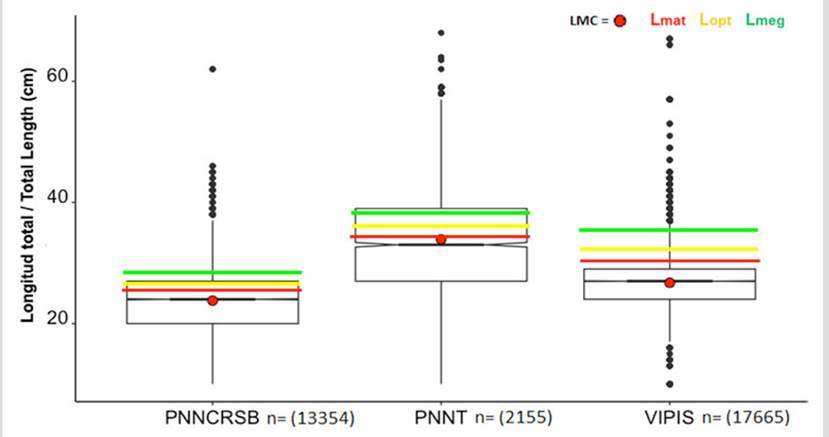
Figure 2 Catch Mean Length (CML) and notched box-and-whiskers diagram based on data from L. synagris caught with all gears and contrasted with Lmat, Lopt and Lmega in the TNNP, SIPW, and CRSBNNP. CRSBNNP: Lmat = 24.6 cm, Lopt = 25.6 cm and Lmega = 28.2 cm; PNNT: Lma = 33.08 cm, Lopt = 35.5 cm and Lmega = 38.5 cm; VIPIS: Lmat = 30.6 cm, Lopt = 32.2, and Lmega = 35.4 cm.
Effect of the fishing gears on L. synagris per protected area
Tayrona National Natural Park. By analyzing L. synagris catch fractions, it was possible to observe that the smallest sizes registered both for handline and set gillnet in the TNNP were 10 cm TL and the largest were 68 cm. 50.6 % of handline-caught fish were below Lmat, 16.7 % were caught between Lmat and Lmega, and 32.7 % above Lmega. With gillnets, 27 % of fish were caught below Lmat, 53.5 % between Lmat and Lmega, and 19.5 %, with lengths larger than Lmega (Figure 3). Regarding the CML, a similar behavior was observed in both fishing gear trends, with a significant year-to-year variation in CML (Kruskal-Wallis: H = 223, p < 2.2 × 10-16 for handline; H = 50.6, p = 5.57 × 10-11 for gillnet), with differences between 2009 and the other years for handline, whereas, in the case of gillnets, 2006 and 2007 were statistically different from 2008 and 2009. However, no differences between the latter were detected (Figure 3).
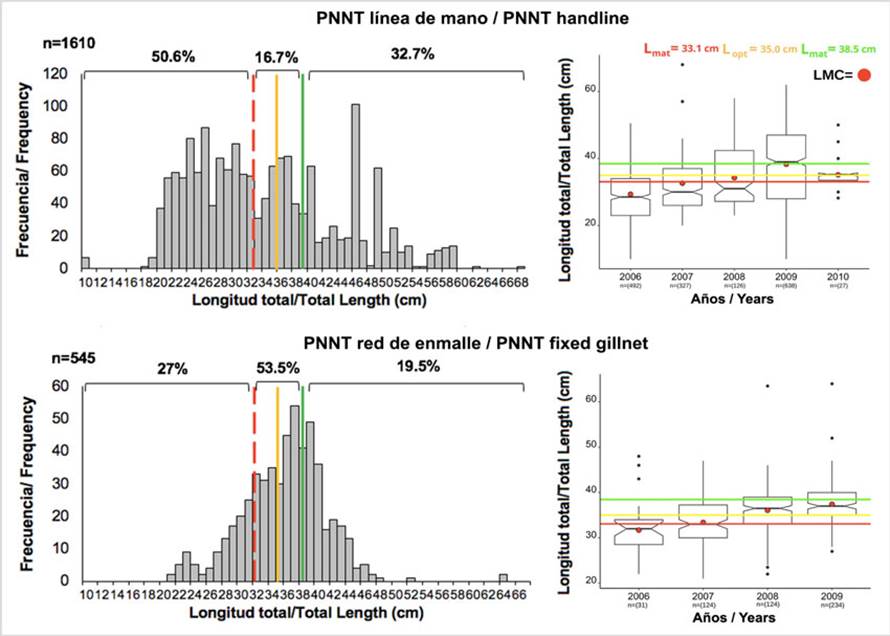
Figure 3 Length-frequency histogram and notched box-and-whisker plot from data of L. synagris caught by handline and fixed gillnet from 2006 to 2009 in the TNNP, and yearly CML contrasted with Lmat (33.08 cm), Lopt (35.5 cm), and Lmega (38.5 cm). n is the sample size.
In all cases, the regressions observed were statistically significant (p < 0.05), tending towards a decrease in catching immature individuals (Figure 4a), whereas, for the fraction of mature ones (Lmat and Lmega), the trend was towards an increase for both gears (Figure 4b). Regarding Lmega, (mega-spawners) a slight trend was observed towards an increase in length catch above this indicator for both gears, which was more noticeable in gillnets (Figure 4c).
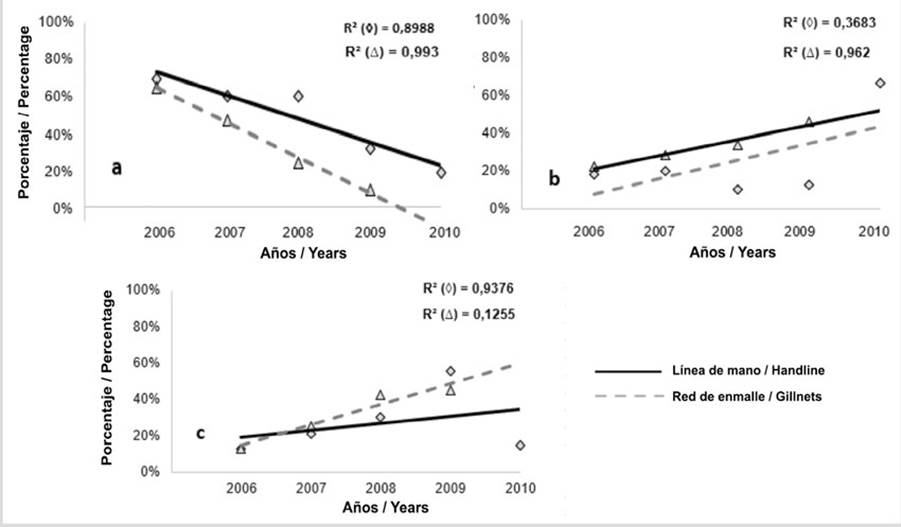
Figure 4 Trend of L. synagris length proportions caught in the TNNP with handline (◊) and gillnets (Δ): a) below the sexual maturity length (Lmat immature), b) between sexual maturity length (Lmat) and mega-spawners length (Lmega) (mature), and c) above Lmega (mega-spawners). The R2 values correspond to the coefficient of determination.
Corales del Rosario y de San Bernardo National Natural Park. 54 % of the individuals caught with handline were below Lmat, 28 % between Lmat and Lmega, and 18 % above Lmega. The highest percentages with gillnet corresponded to caught specimens between Lmat and Lmega (42.5 %) and above Lmega (39 %). Likewise, 35 % of the individuals caught by diving was below Lmat, 40 % between Lmat and Lmega, and 25 % above Lmega (Figure 5). The CML calculated per year for handline was below the reference points Lmat, Lopt, and Lmega for every year, with a significant variation between years (Kruskal-Wallis: H = 1085; p < 2.2 × 10-16). There is a significant difference in 2006, 2007 and 2008, while, from 2009 to 2012 they were statistically equal (Figure 5). There was variation between years for gillnets (Kruskal-Wallis: H = 107.8; p < 2.2 × 10-16), with a difference between 2010 and the other years except 2012 (Figure 5). For the diving method, there was a significant year-to-year difference (Kruskal-Wallis: H = 37.56; p = 3.69 × 10-5), highlighting that, due to the sample sizes, the comparison was only possible between 2008, 2009, and 2011. Likewise, it was noted that 2009 is different from 2008 and 2011 (Figure 5). The CML was below Lmega in the three years, and only in 2009 did it equalize the Lopt value, while, in 2009 and 2011, the values were slightly above Lmat (Figure 5).
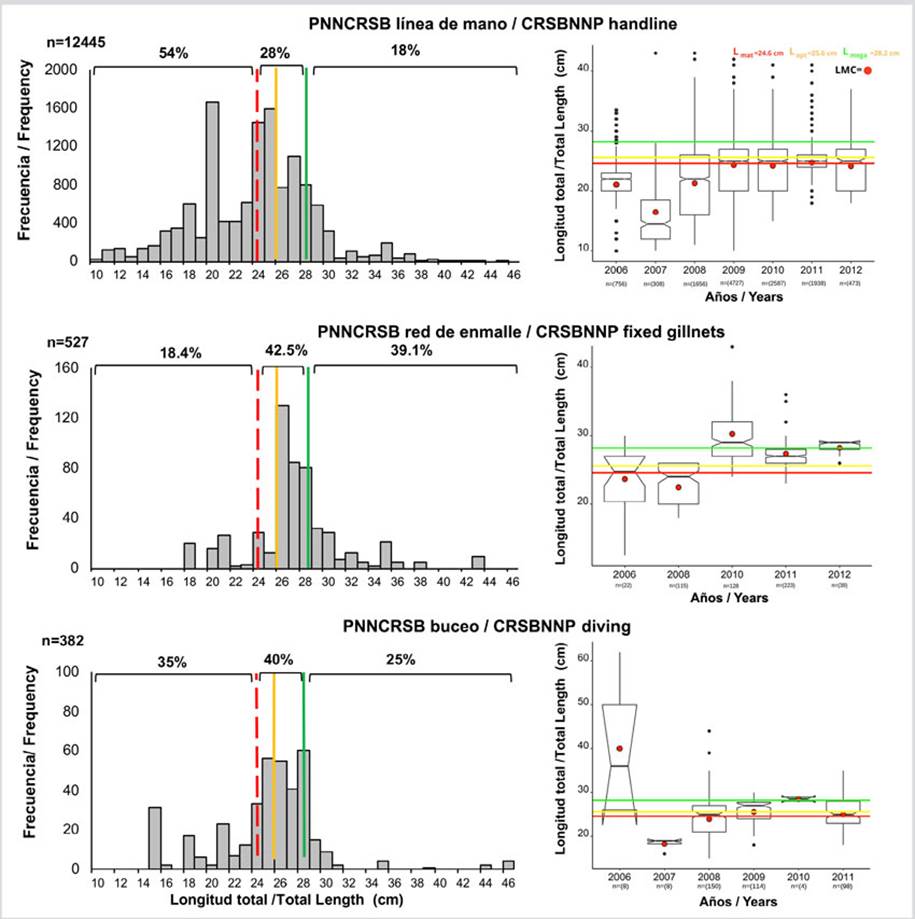
Figure 5 Length-frequency histogram and notched box-and-whiskers plot with data of L. synagris caught by handline, set gillnets, and diving from 2006 to 2012 in the CRSBNNP, and yearly CML contrasted with Lmat (24.6 cm), Lopt (25.6 cm), and Lmega (28.2 cm). n is the sample size.
For most cases, the regressions were statistically significant (p < 0.05), except for the diving method (p > 0.05). As in the TNNP, a trend was observed towards decrease in the catch of immature individuals (Figure 6a), while the mature fraction (Lmat and Lmega) showed an increasing trend, except in diving (Figure 6b). Regarding Lmega (mega-spawners), an increasing trend was observed for the three gears, which was more noticeable in gillnets (Figure 6c).
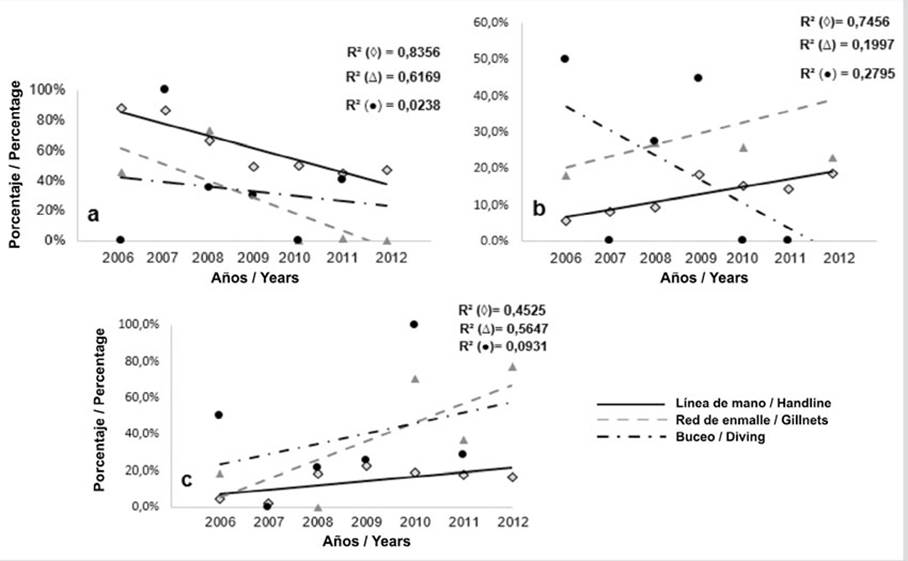
Figure 6 Trend of L. synagris length proportions caught in the CRSBNNP with handline (◊), gillnets (Δ), and by diving (●): a) below the sexual maturity length (Lmat) (immature), b) between Lmat length and Lmega (mature),and c) above Lmega (mega-spawners). The R2 values correspond to the coefficient of determination.
Salamanca Island Park Way. 83.4 % of the specimens caught by longlining were below Lmat, 15.4 % between Lmat and Lmega, and 1.3 % were above Lmega. Regarding gillnets, 95.4 % of the individuals were caught before reaching Lmat, and the remaining 4.6 % were distributed among the other indicators (Figure 7). The behavior of the CML by longlining showed a significant year-to-year variation (Kruskal-Wallis: H = 2783; p < 2.2 × 10-16), with a significant statistical difference between all years, except between 2006 and 2007. The gillnet method showed significant year-to-year variation (Kruskal-Wallis: H = 464.4; p < 2.2 × 10-16), with a significant statistical difference in all years, except between 2010 and 2011 (Figure 7). It was also found that, for all years, the fish catch was below Lmat with both gears, as well as below the other indicators (Figure 7).
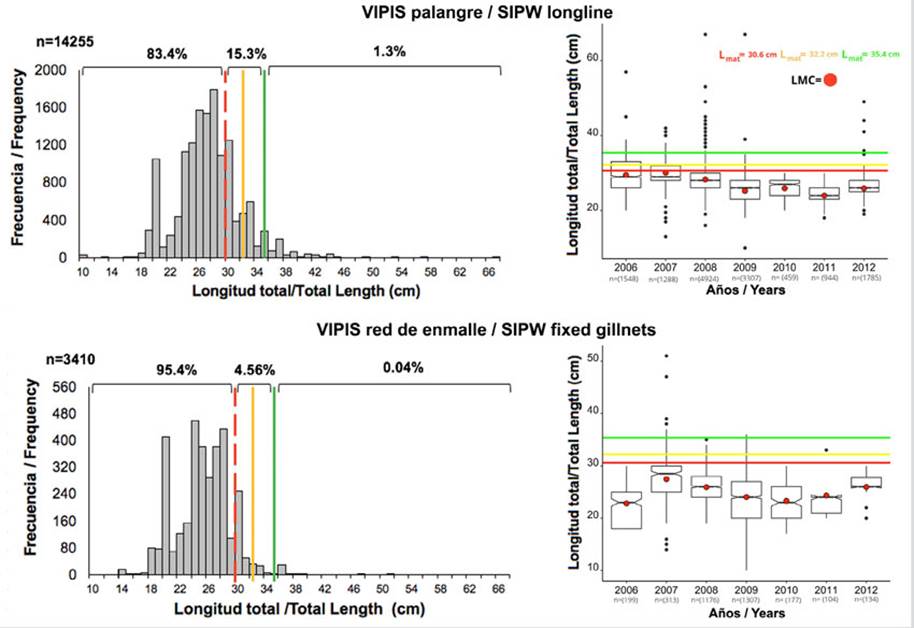
Figure 7 Frequency histogram and notched box-and-whiskers plot from data of L. synagris caught by longline and set gillnet, accumulated from 2006 to 2012 in the SIPW, and yearly CML contrasted with Lmat (30.6 cm), Lopt (32.2 cm), and Lmega (35.4 cm). n is the sample size.
For most cases, regressions were statistically significant (p < 0.05), except for gillnets (p > 0.05). A trend was observed towards the catch of immature individuals with longline, while, for the gillnet method, the behavior was constant and close to 100 % (Figure 8a). The trend of the mature proportion (Lmat and Lmega) and Lmega (mega-spawners) was similar to that of the catch with longline and gillnet (Figure 8b and c).
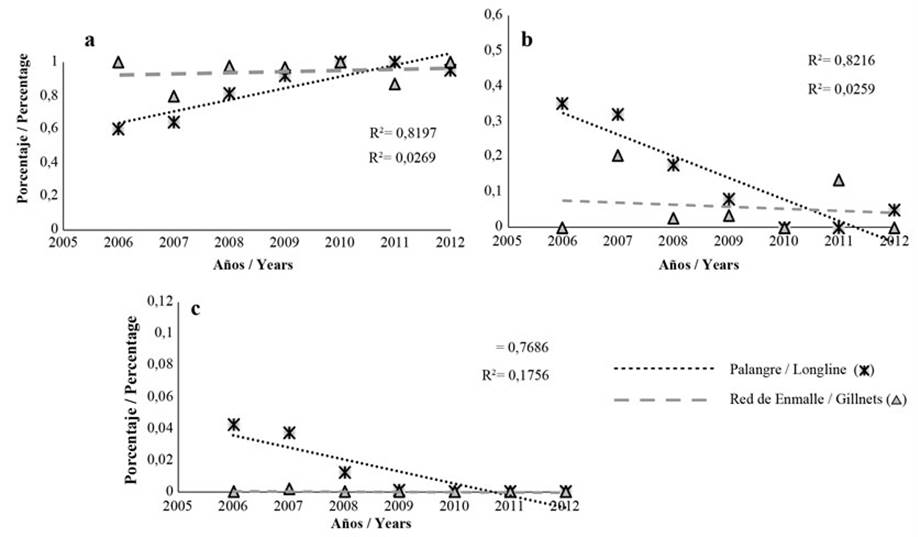
Figure 8 Trend of L. synagris length proportions caught in the SIPW with longline (*) and gillnets (Δ): a) below the sexual maturity length (Lmat) (immature), b) between the sexual maturity length (Lmat) and above mega-spawners Lmega (mature), and c) above Lmega (mega-spawners). The R2 values correspond to the coefficient of determination.
Application of Cope and Punt’s (2009) decision tree
By using Cope and Punt’s decision tree (2009), in the TNNP, the first two evaluated years (2006 and 2007) showed type-2 selectivity (Pobj< 1, but where Popt + Pmega> 0). The fact that, in these years, the Lmat: Lopt ratio and the value of Pmat > 0.25 suggests that the spawning biomass was greater than the target reference point. Therefore, there is no evidence of overfishing. However, for the remaining years, there was type-3 selectivity (where Pobj was between 1 and 2), with the Lmat: Lopt ratio greater than 0.9. However, Pmat was less than 0.9, suggesting that the spawning biomass was less than the target reference point, which is evidence of overfishing.
Regarding the Corales del Rosario NNP, the first three years showed type-2 selectivity (Pobj< 1, but where Popt + Pmega> 0), while the remaining four showed type-3 selectivity (where Pobj was between 1 and 2). Regarding these last four years, the Lmat: Lopt ratio and the value of Pmat< 0.9 suggest that the spawning biomass was less than the target reference point, and, therefore, overfishing signs were observed. Only in 2008 were a Lmat: Lopt ratio and Pmat > 0.25 observed, indicating that the spawning biomass was greater than the target reference point, and, as a consequence, there were no signs of overfishing.
In the SIPW, there was type-2 (Pobj < 1, and Popt+ Pmega > 0) selectivity for all years, with a Lmat: Lopt ratio and Pmat < 0.25, indicating overfishing in the 2008-2012 period. However, only in 2006 and 2007 (out of the seven years observed) there was a Lmat: Lopt ratio and a value of Pmat suggesting that the spawning biomass was greater than the target reference point (Table 1).
Table 1 L. synagris length proportions calculated from the biological reference points-BRP per protected area and year (the decision and interpretation items correspond to the suggestions made by Cope and Punt in 2009). n is the number of individuals; TL: total length; min: minimum length; max: maximum length.
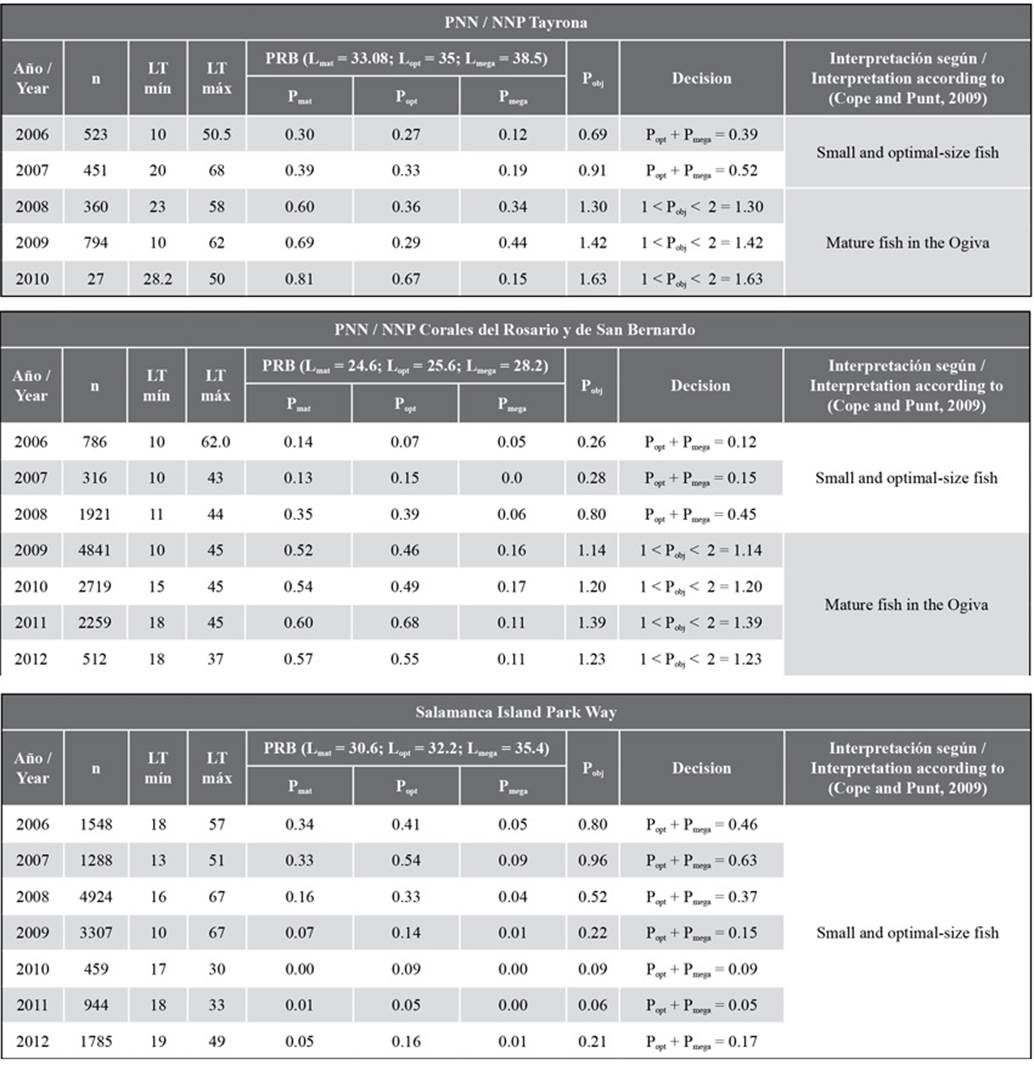
DISCUSSION
It has been documented worldwide that 58.1 % of the fish populations have already reached its maximum sustainable utilization and 31 % are overfished. Moreover, for the last 15 years, the overfished stocks increased by 20 % (FAO, 2018). This behavior is also reflected in the coastal fisheries of the Colombian Caribbean, where maximum exploitation levels and overfishing by growth and recruiting have been observed (Martínez-Viloria et al., 2006; García et al., 2007; Narváez et al., 2008; Barreto and Borda, 2009). This overfishing situation is not unrelated to the protected areas, as this study evidenced it in a multiannual analysis of indicators based on lengths and contrasted with biological reference points of growth and recruiting overfishing in the populations of L. synagris exploited in the CRSBNNP, TNNP, and SIPW.
Variation in the Catch Mean Length and contrast with the reference points
Even though the L. synagris CML was below the recommended values in the three protected areas, the smallest fish on average were caught in the CRSBNNP, which has also been documented by Guzmán (2009), Jaimes (2011), and Martínez-Viloria et al. (2011) in the same area. Likewise, the CML was below Lmat in the TNNP and below Lopt and Lmega, which indicates the magnitude of the impact on the species (López, 2009). In this scenario, it can be inferred that the lane snapper has been unsustainably exploited in the three protected areas, which worsens this species’ situation, considering that the fishermen’s exploitation methods are common in the Colombian Caribbean, and they been practiced for decades (Manjarrés, 1993; Barreto and Borda, 2009; López, 2009; De La Hoz et al., 2013, 2017; Narváez et al., 2013).
Effect of the fishing gears per protected area
Given the evidence that in the TNNP handline and gillnet fishing gears focus most of their catch on mature and immature individuals, it is required that the protective function of the species’ size structure (López, 2009) be strengthened in the protected area. This matter is concerning because some studies have documented that the exploited L. synagris stocks in the Colombian Caribbean are overfished or, at best, close to their exploitation limit (Manjarrés, 2004; Manjarrés et al., 2004; Barreto and Borda, 2009; López, 2009; De La Hoz et al., 2013, 2017; Narváez et al., 2013).
In the CRSBNNP, the handline fishing gear had a higher incidence on the catch of small and immature individuals, in proportions greater that 53 % of the specimens analyzed in this study. The gillnet and diving fishing gears, on the other hand, direct their effort to extracting larger specimens, which suggests the importance of developing strategies to decrease the pressure on this resource according to the established normativity for the CRSBNNP. In a favorable scenario, these strategies could be oriented towards allowing only the catch of fish between Lmat and Lmeg (mature), whose fraction yields the maximum biomass and the best economic income for fishermen (Froese et al., 2008, 2016).
Evidence was found that, in the Salamanca Island Park Way, the longlining and gillnet fishing gears direct their effort towards catching immature individuals in proportions over 83 % for all the registered specimens in the sampled years, which means that the CML is below the reference points Lopt and Lmega in all cases. This situation reflects a selectivity pattern based on the main catch of small fish (Froese et al., 2004).
Despite the above and the efforts made by National Natural Parks towards achieving the conservation targets in the protected areas, their ecosystems, and species, managing the pressure exerted by fishing becomes a challenge, since it is evident that fishing gears are selecting small (immature) fish. This situation is related to the fact that fishermen have designed their fishing gears with small-size hooks and meshes, as previously detailed, which has been also registered by López (2009) and Jaimes, (2011). All the above explains why, in the latter area, caught fish are larger than in the CRSBNNP and SIPW and L. synagris stock in the TNNP is represented by larger size fish in the northern Colombian Caribbean (Gómez-Canchong et al., 2004). The tendency of the artisan fishermen in the Colombian Caribbean to change the characteristics of the fishing gears in order to increase catch is concerning (Martínez -Viloria et al., 2006; Narváez et al.,2008). In the case of the TNNP, it was documented in the 1990s that the gillnet mesh size decreased from 7.62-19.32 cm (3-7.6”) in 1993 to 7.62-10.16 cm (3-4”) in 1999 (López, 2009). Clearly, these changes in the fishing gears bring about a selectivity effect on the target species’ sizes (Pope et al., 1983; Altamar et al., 2020).
Regarding the impact of fishing gears over time, in the L. synagris’ length catch percentages for handline and gillnet gears in the TNNP and the CRSBNNP, there is an observed trend towards a decrease in the catch of immature specimens, as well as a trend towards an increase in the catch of mature and mega-spawners specimens, which is much more noticeable with gillnets. This situation draws attention and suggests the need for reviewing the impact generated on mega-spawner individuals, because the length percentages in catch (up to 56 %) shows signs that indicate the possible erosion of the higher part of the size structure, which is caused by the removal of the largest individuals, an aspect that would affect the resilience capacity of the population (Longhurst, 2002; López, 2009). In the CRSBNNP, the gillnet and diving methods tend more noticeably towards catching mature and mega-spawner specimens in percentages of up to 50 % with diving, and over 75 % with gillnet. This situation suggests that a deeper evaluation of the mega-spawners is required, because the high fertility and genetic transfer that mega-spawners deliver to the system could be compromised (Froese and Binohlan, 2000; Bent-Hooker, 2006). Likewise, handlining was the fishing gear with the highest degree of immature specimen catches in this protected area, an aspect that must be reviewed because it could affect the renovation of the stock that uses the conditions provided by the protected area (Jaimes, 2011; Martínez-Viloria et al., 2011). All of the above contrasts with the observations in the SIPW, where the catch of immature specimens by longlining and gillnet evidences the degree of growth overfishing, which reveals that it has been continuous over time and agrees with Pardo (2011).
Exploitation status of L. synagris according toCope and Punt (2009)
Cope and Punt’s decision tree inferred that, in most of the evaluated years and places, the species had a spawning biomass below the reference points, which indicates the status of overfishing observed through the previously described analyses. The overfishing status would be theoretically impossible if all fish had been able to reproduce before the catch (Myers and Mertz, 1998). Froese suggests that a target between 90 and 100 % of the fish reaching maturity would allow each fish to reproduce at least once before being caught (Froese, 2004). In this study, none of the evaluated sites reached Froese’s target threshold of 90 %. This suggests that most of the caught fish have not been able to reproduce in the population, and this is quite an alarming result.
Marine ecosystems are complex, and it is likely that changes in the system’s individual components have consequences in other places of the same systems (Scheffer et al., 2005). Overfishing affects not only fish population, the trophic networks, and ecosystems, but also the people that depend on fishing for their livelihood, supply, and cultural identity (Cinner et al., 2012; McClanahan et al., 2015; Purcell et al., 2016).
All of the above indicates that the overflow effect status to be fostered by the protective function of the species inside the protected area could be compromised, as the removal of the juvenile and largest specimens of the population would not provide enough biomass to the external sectors of the areas (Froese et al., 2004). This situation worsens for L. synagris since, in most of the fishery landings in the Colombian Caribbean, fishing focuses also on a high percentage of immature fish (Narváez et al., 2013; Duarte et al., 2018), with consequences leading to a decrease in the catch per effort unit (Duarte et al., 2018), and to the loss of genetic variability (Landínez et al., 2009; Narváez et al., 2015).
Finally, it is worth stating that, due to the results obtained in this study, management measures on the use and exploitation of L. synagris must be enhanced within the protected areas, especially considering that not only important habitats for its feeding and reproduction are protected in these areas, but they also constitute an insurance against possible mistakes in fishery management outside them (Austermühle, 2004). The number of fishermen frequenting these areas (~1150 in the three areas; Martínez-Viloria et al., 2014) and those related to the adjacent marine sector hinder control and surveillance actions by the technical staff of National Parks and fishery authorities. This is a global characteristic of artisanal fishery and, given the growing fishing overexploitation (Muallil et al., 2014; Gough et al., 2020), it has become a major inter-institutional challenge in developing countries like Colombia to manage them and to minimize the fishing impacts they cause on the resources. Therefore, fishing management of the resources inside and outside the protected areas must take place within the framework of joint actions involving regional autonomous authorities and those of police, maritime and environmental, and territorial entities; fishing authorities; and National Natural Parks. These actions must include technical-normative, economic, and social aspects aiming to benefit fishermen facing prohibition or the regulation of artisanal commercial fishing, as well as the use of gears that damage the lane snapper resource inside and outside the protected areas.
With this in mind, and considering that the protected areas are deemed a conservation strategy that fosters the offer of hydrobiological resources towards their adjacent sectors through the so-called spillover effect (Roberts et al., 2001; Kaunda-Arara and Rose, 2004; Di Lorenzo et al., 2016) while making such resources exploitable outside the protected areas through different fishing activities -as long as they are responsibly carried out (FAO, 1995)- stronger actions are proposed which comply with the permitted uses inside each PA, such as i) prevention, control, and surveillance with the support of authorities who have environmental protection among their duties, seeking to foster an effective control on PAs through joint actions between National Parks, the National Army, and AUNAP, in order to prevent the catch of immature and mega-spawner stripped snappers; ii) to structure and implement monitoring plans based on the methodology described in this study, which incorporates the obtained results as the baseline and allows validating management actions by monitoring L. synagris catches and the decision-making that contributes to the protection of the species; iii) to develop communication and environmental education strategies by delivering leaflets, talkers in restaurants, videos in the Park’s access points, and awareness-raising days for fishermen and visitors to keep the public informed on the species’ status and why not to consume young or the largest specimens present in protected areas; iv) to generate conservation agreements for subsistence fishing; and v) to strengthen the relationship with other authorities in the region in order to contribute to reducing the pressure on the resource.
CONCLUSIONS
By evaluating the status of L. synagris in the protected areas of NNP Tayrona, NNP Corales del Rosario y de San Bernardo, and Salamanca Island Park way (marine sector), it was found that the species is overfished by growth and recruiting.
The simple indicators based on the catch length configured a selectivity pattern represented by the catch of mainly immature specimens (< Lmat) and individuals located in the optimal length range to a lesser degree, which led to a spawning biomass level lower than the reference point (25 % of SB), according to what is established in the decision tree proposed by Cope and Punt (2009).
The fishing gears are generating a negative effect on the lane snapper populations by mainly catching individuals at a mean catch length MCL below < Lmat, which are considered immature, a more noticeable aspect in the CRSBNNP and the SIPW. Moreover, there is a trend in the catch length percentages, showing signs that do not benefit the species’ status by also removing mega-spawner individuals.
The results obtained in this study evidence that the indicators based on lengths and Cope and Punt’s decision tree are an alternative for National Natural Parks to replicate the model in other protected areas and generate management responses in limited-data situations.











 text in
text in 








